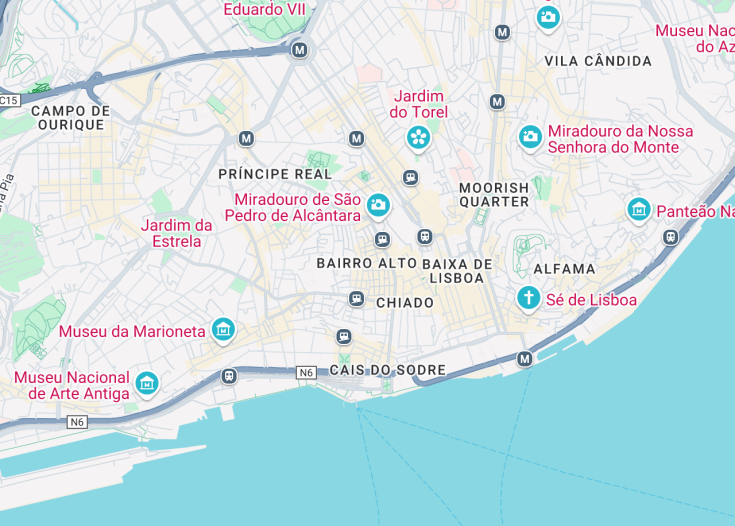Bairro Alto, perched atop one of Lisbon’s iconic seven hills, epitomizes the charming blend of traditional and contemporary urban culture. This vibrant neighborhood is renowned for its historical significance, narrow cobblestone streets, and a lively nightlife that attracts both locals and tourists. By day, Bairro Alto offers a peaceful exploration of quaint shops, historic sites, and authentic Portuguese restaurants. As evening approaches, the area transforms, bustling with the energy of bars and music, making it an essential experience for any visitor to Lisbon.
Plan your visit to Bairro Alto for the late afternoon to seamlessly transition from browsing unique local shops to enjoying the vibrant nightlife scene.
For a truly local experience, dine at a traditional Portuguese restaurant in Bairro Alto, where you can savor dishes like Bacalhau a bras or grilled sardines.
Top things to do & see in Bairro Alto
Select the following sights and activities to discover best tickets and tours available in Bairro Alto.
Bairro Alto: A Historical Treasure in the Heart of Lisbon
| Country | Portugal |
| Time in Bairro Alto | GMT+1 |
| Language spoken | Portuguese |
| Population | 10,000 (source: Latest Census Data) |
| Currency | Euro (EUR €) |
| Airports |
|
Bairro Alto, a picturesque quarter in Lisbon, Portugal, bewitches visitors and locals alike with its blend of traditional charm and contemporary culture. This unique area, known for its narrow cobblestone streets and vibrant nightlife, has been the bohemian hub of Lisbon for more than 500 years. During the day, Bairro Alto is a quiet place where locals go about their daily lives amidst historical buildings. As night falls, the area transforms into one of Lisbon’s most lively nightlife scenes.
The district is notable for its blend of classic and modern architectural styles, with many buildings featuring the traditional Portuguese tiles known as ‘azulejos.’ It’s not just the architecture that attracts people; it is also famous for its numerous small restaurants, ‘tascas’ (taverns) that serve a variety of traditional and international foods, and Fado houses where the haunting sounds of the Portuguese guitar and melancholic singers draw you in.
The historical significance of Bairro Alto extends back to the 16th century when it was developed as a response to the growing need for housing outside Lisbon’s walls. Today, it’s celebrated as a major cultural and bohemian district, embodying a vibrant mix of old and new, traditional and cutting-edge. It’s not only a nightlife paradise but also a daytime sanctuary for photographers and adventurous tourists seeking to uncover the layered stories of Lisbon’s past intertwined with the dynamic pulse of its present.
Where is Bairro Alto?
Bairro Alto is situated in the central area of Lisbon, perched on one of the city’s seven hills, bordered by the bustling areas of Chiado and Principe Real.
Distances:
| Route | Distance by car | Time by car |
|---|---|---|
| Lisbon to Bairro Alto | 1.2 miles | 10 minutes |
| Porto to Bairro Alto | 196 miles | 3 hours |
| Faro to Bairro Alto | 174 miles | 2 hours 50 minutes |
What is Bairro Alto famous for?
Bairro Alto is famous for its vibrant nightlife and historical significance. With its numerous bars, music venues, and traditional Fado houses, it offers a captivating mix of old-world charm and contemporary urban culture.
History
1500s: The Founding Era
The inception of Bairro Alto dates back to the 16th century, initially established to accommodate the growing population of Lisbon. It quickly developed into a thriving residential and commercial area, attracting merchants and artisans.
1700-1800: The Cultural Hub
During this period, Bairro Alto became a nucleus for cultural activities, hosting numerous newspapers and literary societies. Notably, the famous Bairro Alto Theatre added to its cultural landscape, paralleled by an influx of cafes and theaters.
1900s: The Bohemian Period
Throughout the 20th century, Bairro Alto evolved into a bohemian quarter, where intellectuals, artists, and writers gathered. This era marked its transformation into a popular entertainment district, bustling with nightclubs and bars.
Modern Day
Today, Bairro Alto stands as an emblematic symbol of Lisbon’s historical and cultural heritage, continually adapting to the modern world while preserving its rich past.
Visit Bairro Alto
What to see and do in Bairro Alto
Explore the stunning convergence of historical architecture and contemporary culture in Bairro Alto. Key attractions include:
- Roaming the picturesque streets adorned with colorful graffiti
- Visiting the São Roque Church with its magnificent baroque interiors
- Enjoying a night out at some of Lisbon’s most traditional Fado houses
- Experiencing the vibrant nightlife at various bars and clubs
Festive Spirit in Bairro Alto
Bairro Alto pulsates with festivals throughout the year, notably the São Pedro de Alcântara Festival in summer and the bohemian Bairro Alto Street Fest every fall, showcasing live music, food stalls, and art exhibitions.
Best time to visit Bairro Alto
For a pleasant trip, visit during spring (March to May) or fall (September to November). During these months, the weather is mild, and the city is less crowded, offering a more fulfilling experience.
Is Bairro Alto worth visiting?
Bairro Alto is unquestionably worth visiting for its blend of historical charm and vibrant nightlife. Whether you are a cultural enthusiast eager to explore historic sites or someone looking to enjoy bustling nightlife, Bairro Alto offers a dynamic and enriching urban adventure, making it a must-see destination in Lisbon.










